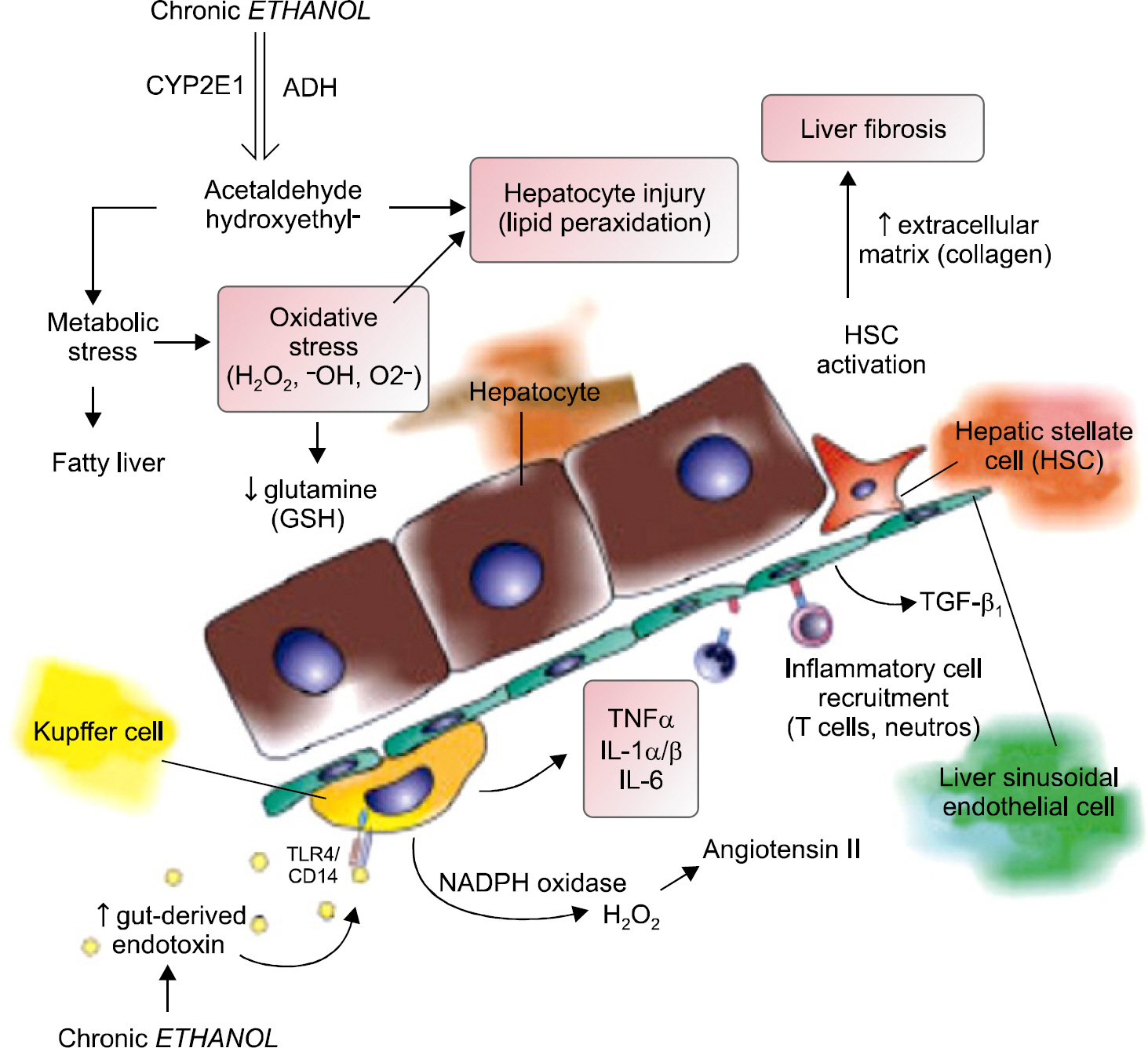Korean J Gastroenterol.
2009 May;53(5):275-282. 10.4166/kjg.2009.53.5.275.
Alcoholic Liver Disease
- Affiliations
-
- 1Department of Internal Medicine, Chungbuk National University College of Medicine and Medical Research Institute, Cheongju, Korea. bchae@chungbuk.ac.kr
- KMID: 1767681
- DOI: http://doi.org/10.4166/kjg.2009.53.5.275
Abstract
- A study conducted 15-year ago showed that only 13.5% of chronic alcoholics developed alcohol-induced liver damage, which misled some people to believe a lack of relationship between the amount of alcohol and the occurrence of liver disease. However, it is true that a significant correlation exists between per capita consumption and the prevalence of cirrhosis. Alcoholic fatty liver is observed in most of chronic alcoholics even though the severity is not uniform. Abstinence remains the cornerstone of therapy for alcoholic liver disease (ALD). There is also consensus for the use of corticosteroids and pentoxifylline in severe alcoholic hepatitis maintaining good nutritional status to treat comorbidities in all forms of ALD, and liver transplantation in the end-stage ALD patients who can stop drinking for 6 months pre-transplantation period. Several clinical trials targeting tumor necrosis factor (TNF-alpha) and reducing oxidative stress have not been successful at this time. There is still a large field of alcohol research to explore in order to go farther in the area of pathophysiology. We need to understand a role of various cytokines and immune cells in the development of ALD to have more treatment tools to cope with ALD.
Keyword
MeSH Terms
Figure
Reference
-
1. Lee CH. Alcoholic liver disease. Kim JR, editor. ed.Diseases of the digestive system. 1st ed.Reston: Ilchogak;2000. 578-583.2. Hellman RA, Telko MH, Nye SW, et al. Alcoholic hepatitis natural history and evaluation of prednisolone therapy. Ann Intern Med. 1971; 74:311–321.3. Akriviadis E, Botla R, Briggs W, Han S, Reynolds T, Shakil O. Pentoxifylline improves short-term survival in severe acute alcoholic hepatitis: a double-blind, placebo-controlled trial. Gastoenterology. 2000; 119:1637–1648.
Article4. Anland BS. Cirrhosis of the liver. West J Med. 1999; 171:110–115.5. Mann RE, Anglin L, Wilkins K, Vinglilis ER, MacDonald S. Mortality in a sample of convicted drinking drivers. Addiction. 1993; 88:643–647.
Article6. Enomoto N, Takase S, Takeda N, Takeda A. Alcoholic liver disease in heterozygotes of mutant and normal aldehyde de-hydrogenase-2 genes. Hepatology. 1991; 13:1071–1075.
Article7. Kee JY, Kim MO, You IY, et al. Effects if genetic polymorphisms of ethanol-metabolizing enzymes on alcohol drinking behaviors. Korean J Hepatol. 2003; 9:89–97.8. Byun KS, Kwon SY, Park SH, et al. The role of mitochondrial aldehyde dehydrogenase (ALDH2) deficiency in Koreans with alcoholic liver disease. Korean J Med. 1993; 45:328–337.9. Tsukamoto H, Xi XP. Incomplete compensation of enhanced hepatic oxygen consumption in rats with alcoholic cen-trilobular liver necrosis. Hepatology. 1985; 9:302–306.
Article10. Martinez-Chantar ML, Garcia-Trevijano ER, Latasa MU, et al. Importance of a deficiency in S-adenosyl-L-methionine synthesis in the pathogenesis of liver injury. Am J Clin Nutr. 2002; 76:1177S–1182S.11. Mathurin P, Abdelnour M, Ramond MJ, et al. Early change in bilirubin levels is an important prognostic factor in severe alcoholic hepatitis treated with prednisolone. Hepatology. 2003; 38:1363–1369.
Article12. Rambaldi A, Gluud C, Rambaldi A. Propylthiouracil for alcoholic liver disease. Cochrane Database Syst Rev. 2005; 4:CD002800.
Article13. Phillips M, Curtis H, Portmann B, Donaldson N, Bomford A, O'Grady J. Antioxidants versus corticosteroids in the treatment of severe alcoholic hepatitis-a randomized clinical trial. J Heptol. 2006; 44:784–790.14. Cabre E, Rodriguez-Iglesias P, Caballeria J, et al. Short- and longterm outcome of severe alcohol-induced hepatitis treated with steroids or enteral nutrition: a multicenter randomized trial. Hepatology. 2000; 32:36–42.
Article15. Naveau S, Chollet-Martin S, Dharancy S, et al. for the Foie-Alcohol group of the Association Francaise pour I'Etude du Foie. A double- blind randomized controlled trial of infliximab associated with prednisolone in acute alcoholic hepatitis. Hepatology. 2004; 39:1390–1397.16. Menon KV, Stadheim L, Kamath PS, et al. A pilot study of the safety and tolerability of etanercept in patients with alcoholic hepatitis. Am J Gastroenterol. 2004; 99:255–260.
Article17. Powell WJ Jr, Klatskin G. Duration of survival in patients with Laennec's cirrhosis. Influence of alcohol withdrawal, and possible effects of recent changes in general management of the disease. Am J Med. 1968; 44:406–420.18. Zetterman RK. Liver transplantation for alcoholic liver disease. Clin Liver Dis. 2005; 9:171–181.
Article19. Dunn W, Jamil LH, Brown LS, et al. MELD accurately predicts mortality in patients with alcoholic hepatitis. Hepatology. 2005; 41:353–358.
Article20. Forrest EH, Evans CD, Stewart S, et al. Analysis of factors predictive of mortality in alcoholic hepatitis and derivation and validation of the Glasgow Alcoholic Hepatitis Score. Gut. 2005; 54:1174–1179.
Article
- Full Text Links
- Actions
-
Cited
- CITED
-
- Close
- Share
- Similar articles
-
- Should you advocate for hepatocellular carcinomasurveillance in patients with alcohol-related liverdisease or non-alcoholic fatty liver disease?
- KASL Clinical Practice Guidelines: Management of Alcoholic Liver Disease
- Managements of the alcoholic liver diseases
- Psychosocial Characteristics of Patients with Alcoholic Liver Disease
- How to optimize the outcome of liver transplantation for non-alcoholic fatty liver disease


